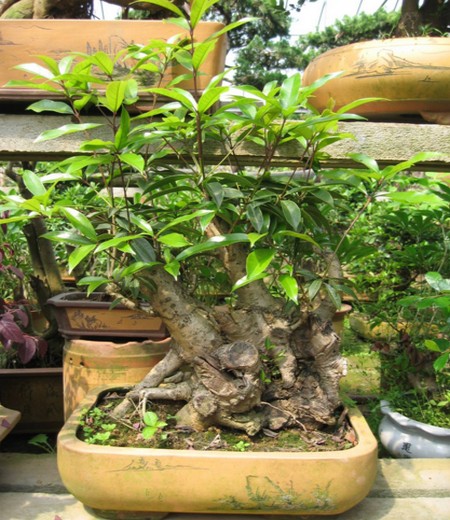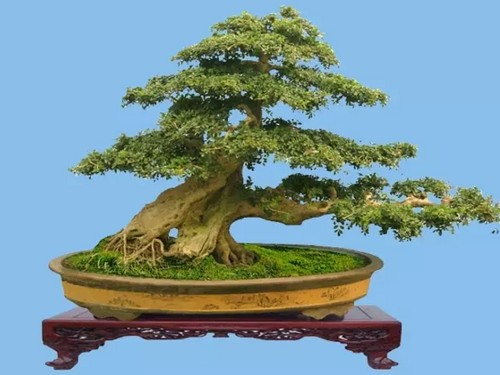The method of making persimmon bonsai
Persimmon bonsai trunk ancient strange, strong twists and turns, oblique dry, the branches are empty, natural and orderly. A multi-stem uneven height, hanging roots and claws, branches and leaves sparse, unique, spectacular and deep. The straight curve between the stem and the branch changes and stretches freely, which not only embodies the interest of the mountains and forests, but also has a unique artistic flavor. The young branches are bright green, the mature leaves are dark green and flat, and the ancients said that the leaves are fat and slippery. In autumn, red leaves are like fire, which can be comparable with maple leaves. The flowers are peculiar in shape, small and golden, with a light fragrance. The fruit varies in size and shape. The fruit color changes from green to orange-yellow or orange-red, and does not fall through winter, very much like the red lanterns hanging all over the branches during the auspicious festival. it is dazzling, gorgeous and attractive, symbolizing "good wishes every year". It is actually a good product for the family to watch the leaves and enjoy the fruits or give gifts to relatives and friends.
The seedlings of Junqianzi, wild persimmon and oil persimmon can be used as rootstocks for making bonsai, and high ornamental value persimmon varieties such as Mopan persimmon, fire persimmon, pomegranate persimmon and Luofu persimmon can be used as scions to be grafted by split grafting or cutting grafting in spring. It can also be excavated and grown in the field for many years after falling leaves in autumn and before sprouting in spring. The simple and vigorous stump of Junqianzi can be grafted in the spring of the following year after one year of "raising billet".
Because of the high content of tannin in the root of Junqian seed, it is difficult to heal after injury, and the tree potential recovers slowly after transplantation. therefore, the root system should be preserved as far as possible when transplanting, and pay attention to fresh and moisturizing to ensure survival. For the first time, it is appropriate to use a tile basin of suitable size to promote the growth of the root system and speed up the forming speed.
Persimmon originally belongs to a deciduous tree species, which can grow up to more than 20 meters, but because of its excellent fruit effect, it is also used as a good material for bonsai. Although the persimmon trees after bonsai art modeling have shrunk a lot, their ornamental value has not decreased, on the contrary, some well-made bonsai can also enhance the ornamental value of persimmon trees.
Persimmon trees can not only produce sweet and delicious persimmons for people to taste, but also a very good material for bonsai, which can be shaped into bonsai to improve the quality of the living room.
1. Select piles and pick piles:
The seedlings of Junqianzi, wild persimmon and oil persimmon can be used as rootstocks for making bonsai, and high ornamental value persimmon varieties such as Mopan persimmon, fire persimmon, pomegranate persimmon and Luofu persimmon can be used as scions to be grafted by split grafting or cutting grafting in spring. It can also be excavated and grown in the field for many years after falling leaves in autumn and before sprouting in spring. The simple and vigorous stump of Junqianzi can be grafted in the spring of the following year after one year of "raising billet".
2. Potted soil selection:
Persimmon originates from the Yellow River Basin to the south of the Yangtze River Basin in China. It likes a sunny, warm and humid environment, but it is also resistant to drought and cold, and grows well in deep, fertile and well-drained soil. Therefore, it is appropriate to plant in deeper flowerpots.
3. Modeling and shaping:
According to the shape of rootstock and the variety characteristics of scion, persimmon bonsai can be processed into single-dry type, double-dry type, oblique dry type, water-facing type, literati tree and other different forms of bonsai. Because of its large leaves, the crown is mostly natural, and its bright fruit hangs among the green leaves, which is very beautiful, while after falling leaves in winter, the branches such as iron have some characteristics. The modeling method adopts the combination of pruning and flat binding, which is cultivated gradually to make the branch thickness transition natural and the proportion coordinated.
4. Thinning buds:
When 2-4 fruiting branches were produced on the mother branch, 3 buds in the middle of the first 2 fruiting branches were retained, and all the buds on the other fruiting branches were removed and reserved as reserve branches. If the fruiting mother branch produces more than 5 fruiting branches, the first 3 fruiting branches should be retained, with 3 flowers in the middle of each fruiting branch, and the rest should be thinned out.
5. Skillfully apply fertilizer and water:
For big trees entering the peak fruiting period, it is necessary to strengthen fertilizer and water management, apply base fertilizer early in spring and full base fertilizer in autumn, but topdressing should not be premature. Generally, topdressing is applied in the withered top period of branches in May and the fruit expansion period in July, which can not only obviously promote the fruit setting rate, but also increase the number and quality of flower buds in the next year, and water them in case of dry weather.
6. Chemical regulation:
Spraying 500ppm gibberellin plus 1% urea at full flowering stage and young fruit stage can improve the nutritional status of flowers and fruits, prevent the separation of persimmon stalks and stalks, enhance the nutrient absorption function of flowers and young fruits, stimulate the expansion of ovary, and increase the fruit setting rate; during the period of rapid fruit expansion, foliar spraying 0.3% 0.5% urea solution and ammonium key acid and other trace element fertilizers can reduce flower and fruit drop.
Generally speaking, persimmon bonsai is relatively easy to maintain, because there is no special need for technology, generally as long as daily care can be achieved, persimmon trees can bear fruitful fruits in potted plants.
Time: 2019-05-26 Click:
- Prev

Making method of bonsai with stone of sweet-scented osmanthus
In principle, the production of sweet-scented osmanthus bonsai requires far-reaching composition; learning from natural reality; developing strengths and avoiding weaknesses; combining dynamic and static dexterity; unified coordination and eye-pleasing; small and medium-sized insights; appropriate density; clear primary and secondary eye-catching. The bonsai with stone of sweet-scented osmanthus inherits and carries forward the tradition of Lingnan School, learning from nature and shrinking the size of the dragon.
- Next

The method of making jungle bonsai with white wax
The Junction White Wax jungle bonsai is made up of several materials planted in a basin to make them reflect each other to form an artificial natural community to reproduce the beautiful scenery of the forest and sea. It wins by the overall beauty of the natural combination, rather than expressing its own individual characteristics.
Related
- Fuxing push coffee new agricultural production and marketing class: lack of small-scale processing plants
- Jujube rice field leisure farm deep ploughing Yilan for five years to create a space for organic food and play
- Nongyu Farm-A trial of organic papaya for brave women with advanced technology
- Four points for attention in the prevention and control of diseases and insect pests of edible fungi
- How to add nutrient solution to Edible Fungi
- Is there any good way to control edible fungus mites?
- Open Inoculation Technology of Edible Fungi
- Is there any clever way to use fertilizer for edible fungus in winter?
- What agents are used to kill the pathogens of edible fungi in the mushroom shed?
- Rapid drying of Edible Fungi

